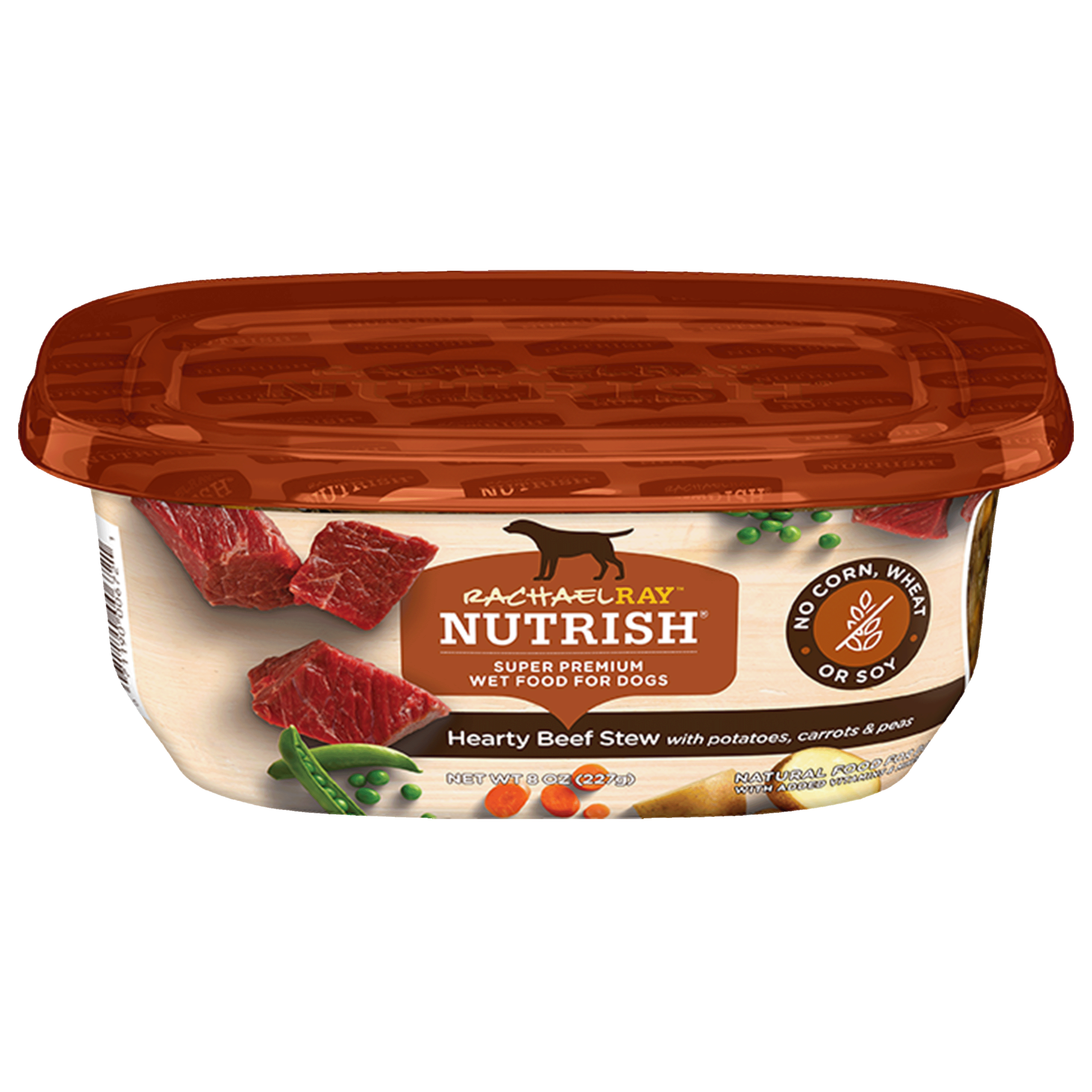
DogFoodAdvisor is reader supported See how
All reviews are 100% impartial but if you buy using links on this page, we may earn a referral fee.
Our Verdict
Nutrish Trays is a product range made up of five recipes which each receive the Dog Food Advisor’s rating, 3.5 stars.
Each of these recipes contains chunky bites of protein and vegetables in a savory gravy, making it ideal for dogs who struggle with digestibility.
Nutrish was formerly known as Rachael Ray Nutrish. It rebranded in 2025.
Pros
- No corn, wheat or soy and no artificial fillers or flavors
- Affordable
- High in protein
Cons
- Added color
The table below shows each recipe in this range including our rating and the AAFCO nutrient profile: Growth (puppy), Maintenance (adult), All Life Stages, Supplemental or Unspecified.
| Product line | Rating | AAFCO |
|---|---|---|
| Nutrish Chicken Paw Pie | 3.5 | A |
| Nutrish Hearty Beef Stew | 3.5 | A |
| Nutrish Beef Stroganwoof | 3.5 | A |
| Nutrish Savory Lamb Stew | 3.5 | A |
| Nutrish Chicken Muttballs with Pasta | 3.5 | A |
Recipe and Label Analysis
Nutrish Hearty Beef Stew was selected to represent the other products in the line for detailed recipe and nutrient analysis.
Nutrish Hearty Beef Stew
Estimated Dry Matter Nutrient Content
Protein
Fat
CarbsCarbohydrates
Chicken broth, beef, chicken, dried egg product, egg white, pea protein, natural flavor, potato, carrots, green pea, ground tapioca, dicalcium phosphate, guar gum, caramel (color), potassium chloride, salt, choline chloride, calcium carbonate, fish oil, zinc proteinate, iron proteinate, magnesium sulfate, celery powder, vitamin E supplement, l-ascorbyl-2-polyphosphate (source of vitamin C), thiamine mononitrate, niacin, copper proteinate, manganese proteinate, vitamin A acetate, calcium iodate, calcium pantothenate, sodium selenite, riboflavin, vitamin B12 supplement, pyridoxine hydrochloride (source of vitamin B6), folic acid, vitamin D3 supplement, biotin, menadione sodium bisulfite complex (source of vitamin K activity).
Fiber (estimated dry matter content) = 2%
Red denotes any controversial items
| Estimated Nutrient Content | |||
|---|---|---|---|
| Method | Protein | Fat | Carbs |
| Guaranteed Analysis | 9% | 5% | NA |
| Dry Matter Basis | 41% | 23% | 28% |
| Calorie Weighted Basis | 33% | 44% | 23% |
Ingredients Analysis
The first ingredient in this dog food is chicken broth. Broths are of only modest nutritional value. Yet because they add both flavor and moisture to a dog food, they are a common addition component in many canned products.
The second ingredient is beef. Beef is defined as “the clean flesh derived from slaughtered cattle” and includes skeletal muscle or the muscle tissues of the tongue, diaphragm, heart or esophagus.1
The third ingredient is chicken. Chicken is considered “the clean combination of flesh and skin… derived from the parts or whole carcasses of chicken”.2
Both beef and chicken are naturally rich in the 10 essential amino acids required by a dog to sustain life.
The next ingredient is dried egg product, a dehydrated form of shell-free eggs. Quality can vary significantly. Lower grade egg product can even come from commercial hatcheries — from eggs that have failed to hatch.
In any case, eggs are easy to digest and have an exceptionally high biological value.
The fifth ingredient lists dried egg whites. Eggs are highly digestible and an excellent source of usable protein.
The sixth ingredient is pea protein, what remains of a pea after removing the starchy part of the vegetable.
Even though it contains over 80% protein, this ingredient would be expected to have a lower biological value than meat.
And less costly plant-based products like this can notably boost the total protein reported on the label — a factor that must be considered when judging the meat content of this dog food.
The seventh ingredient is natural flavors, doesn’t give us much information about the particular ingredients included in this dog food for flavoring purposes.
We’re pleased that the flavorings used are natural, but more details are required to give any further information about these natural flavoring ingredients. Flavorings are used to make the foods more appealing and tasty for our dogs.
After the natural flavor, we find potato. Potatoes can be considered a gluten-free source of digestible carbohydrates. Yet with the exception of perhaps their caloric content, potatoes are of only modest nutritional value to a dog.
From here, the list goes on to include a number of other items.
But to be realistic, ingredients located this far down the list (other than nutritional supplements) are not likely to affect the overall rating of this product.
With three notable exceptions…
First, we find peas. Peas are a quality source of carbohydrates. And like all legumes, they’re rich in natural fiber.
However, peas contain about 25% protein, a factor that must be considered when judging the meat content of this dog food.
Next, caramel is a natural coloring agent made by caramelizing carbohydrates. It’s used by pet food manufacturers to impart a golden brown tint to the finished product.
However, the concentrated version of this ingredient commonly known as caramel coloring has been more recently considered controversial and found to cause cancer in laboratory animals.3
In any case, even though caramel is considered safe by the FDA, we’re always disappointed to find any added coloring in a pet food.
That’s because coloring is used to make the product more appealing to humans — not your dog. After all, do you really think your dog cares what color his food is?
In addition, this food contains chelated minerals, minerals that have been chemically attached to protein. This makes them easier to absorb. Chelated minerals are usually found in better dog foods.
Nutrient Analysis
Based on its ingredients alone, Nutrish Hearty Beef Stew looks like an average wet product.
The dashboard displays a dry matter protein reading of 40.4%, a fat level of 23.1% and estimated carbohydrates of about 23.1%.
As a group, the brand features an average protein content of 40.4% and a mean fat level of 23.1%. Together, these figures suggest a carbohydrate content of 23.1% for the overall product line.
And a fat-to-protein ratio of about 57%.
Which means this Nutrish product line contains…
Near-average protein. Near-average fat. And near-average carbs when compared to other wet dog foods.
When you consider the protein-boosting effect of the pea protein and peas, this looks like the profile of a wet product containing a moderate amount of meat.
Nutrish Dog Food Recall History
The following automated list (if present) includes all dog food recalls related to Nutrish through December 2025.
No recalls noted.
You can view a complete list of all dog food recalls since 2009 here.
Our Rating of Nutrish Dog Food
Nutrish Trays are a moisture-rich dog food that uses a moderate amount of named meats as the main source of animal protein. It’s unfortunate that the company chose to include caramel color in each of its recipes, which is why the brand earned 3.5 stars. Otherwise, we would have been compelled to give this product a higher rating.
About
Rachael Ray Nutrish was a brand created by celebrity chef and TV personality Rachael Ray. It was purchased by Ainsworth Pet Nutrition in 2018, a division of The J. M. Smucker Company of Orville, Ohio.
Rachael Ray Nutrish is now simply Nutrish, a rebranding with a new packaging launch in 2025
All dry foods are produced in the United States. Wet recipes are made in Thailand.
Compare Nutrish Dog Food
How does Nutrish compare with The Dog Food Advisor's most recommended brands?
A Final Word
The Dog Food Advisor does not accept money, gifts, samples or other incentives in exchange for special consideration in preparing our reviews.
However, we do receive a referral fee from online retailers (like Chewy or Amazon) and from sellers of perishable pet food when readers click over to their websites from ours. This helps cover the cost of operation of our free blog. Thanks for your support.
For more information, please visit our Disclaimer and Disclosure page.









